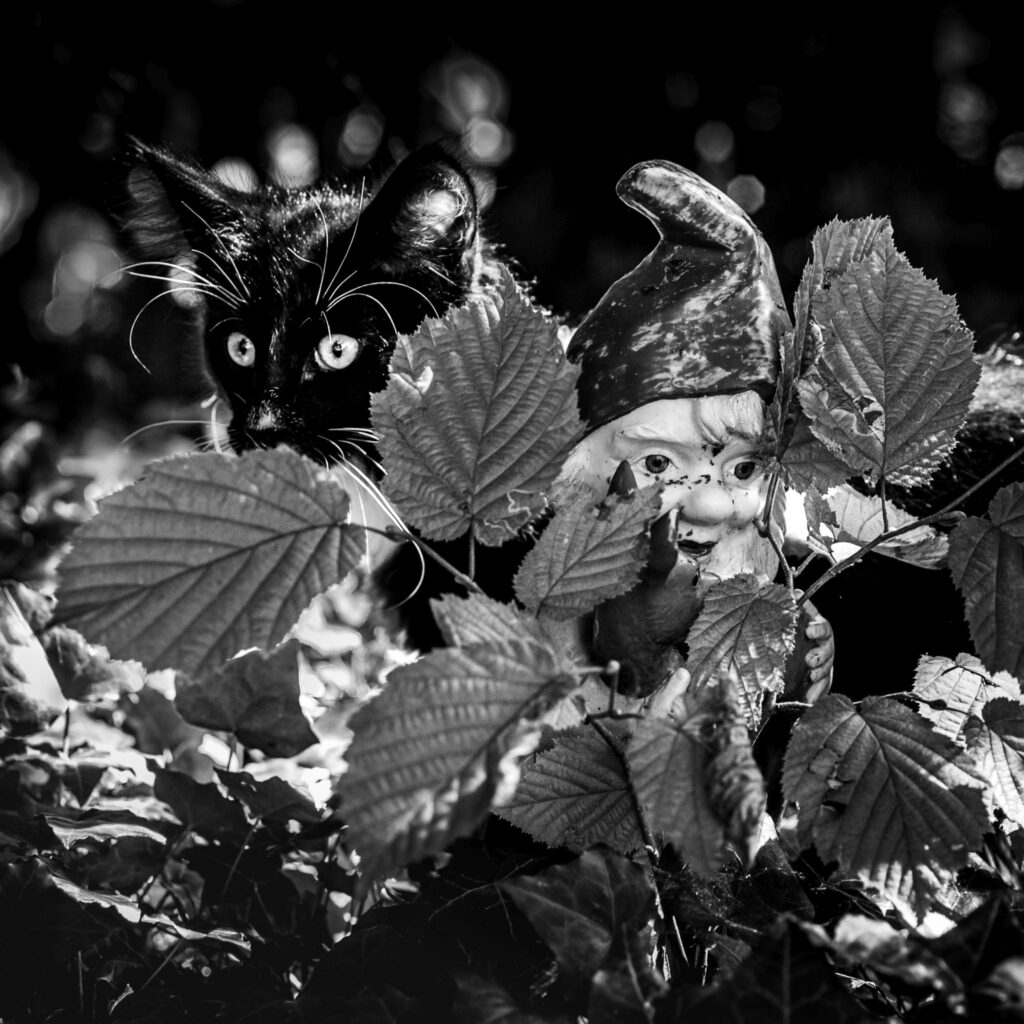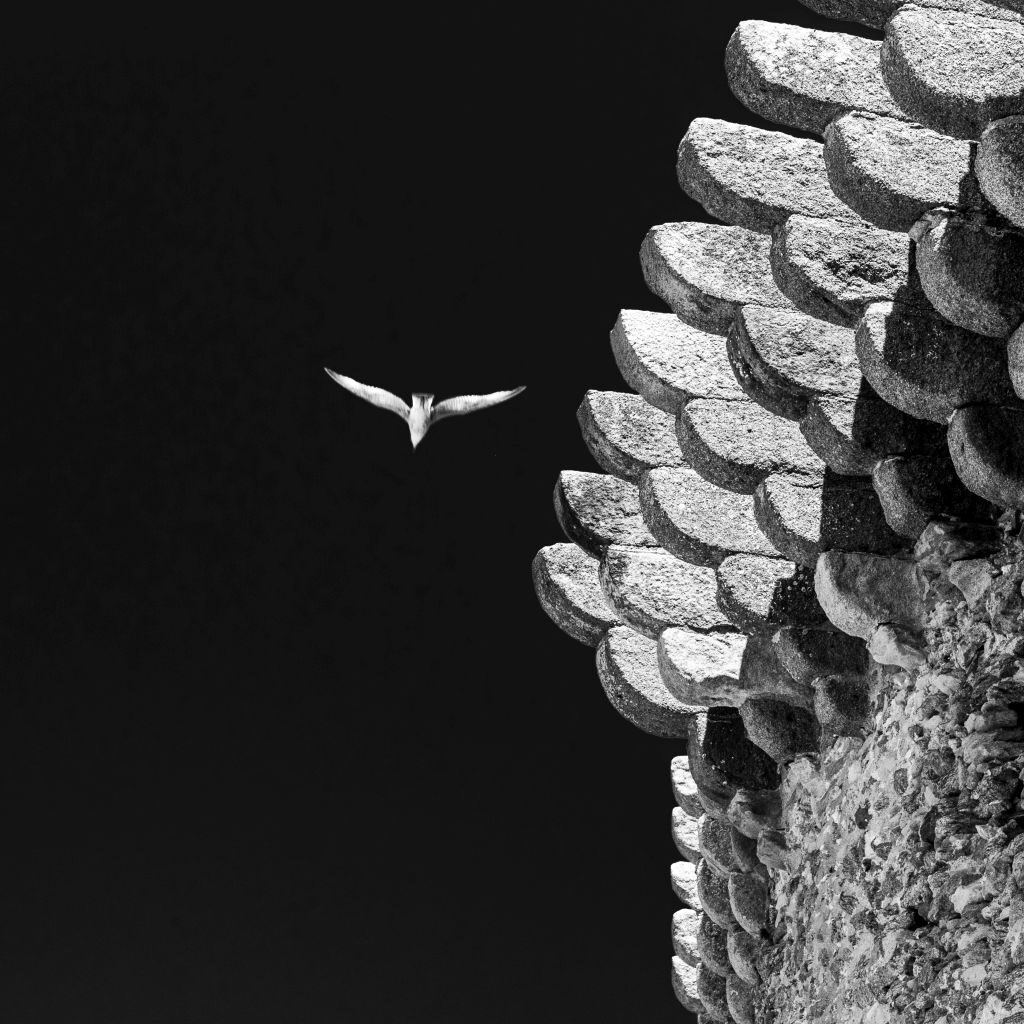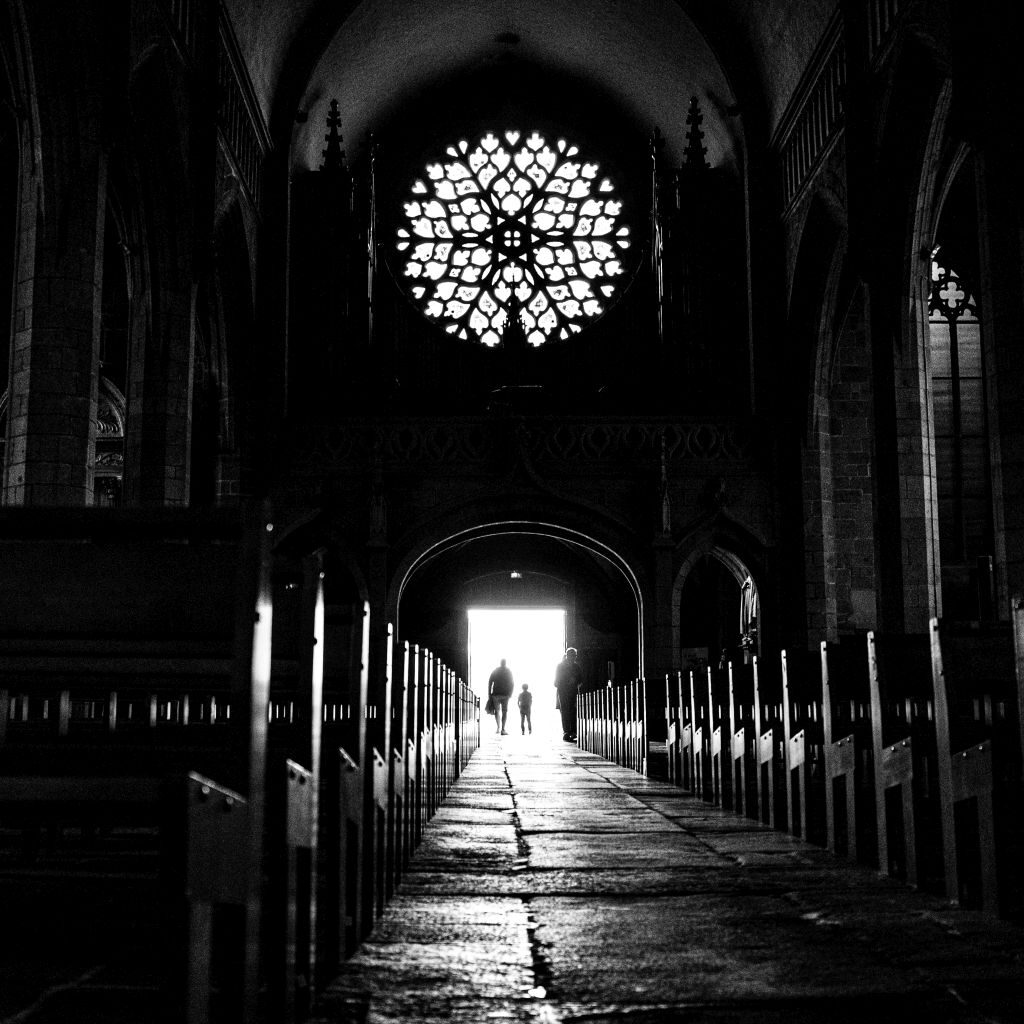
Hasselblad 907x CFV II 50C, XCD 65, F 3.4, 1/125 sec, ISO 400
German text after the English version
The story behind the photo “in ambush” is a nice example of my preferred working method in street photography, which is based on “not-so-coincidental coincidences”. One Sunday morning my partner Susann drew my attention to the photogenic light under a tree in our garden. I had seen a funny photo with a portrait of a garden gnome in a picture book about Switzerland many years ago and thought this would be a good idea for such a staging.
I went into the garden and placed one of our gnomes decoratively in the morning light. Despite several pictures in different positions, however, I was not really convinced by the result: technically neatly executed, but irrelevant. The certain something was missing. But where to take from and not steal? At that moment, the young neighbour’s cat “Idefix” came by and fulfilled my wish by posing next to the garden gnome. What I like most about the picture is the eye alignment of the two protagonists. They look like robbers hiding behind the bushes at the side of the road, looking for their next victim.

Hasselblad 907x CFV II 50 C, XCD 65, F 16, 1/250 sec, ISO 400
These not entirely coincidental coincidences are often behind my pictures. I see a beautiful situation and then wait until the icing on the cake appears. Another example is the above picture of the city walls of Saint-Malo. This city is by the sea, which is why there are always seagulls flying around the wall. However, I already had a slight sunburn on the back of my bald head and a lame arm until finally a seagull flew through the picture at the right height and direction…

Hasselblad 907x CFV II 50 C, XCD 30, F 3.5, 1/125 sec, ISO 3200
In addition to physical ailments, the ambitious photographer must not have any inhibitions about behaving a little oddly in public. For the above picture, I sat patiently on the floor in front of the altar of a Catholic church in the North of France and waited until the right subject appeared in the doorway. I stoically ignored the looks of the other visitors who oscillated between amazement and indignation and who muttered some unfriendly remarks to themselves. Fortunately, the boy and the old man appeared in the entrance before I was picked up by the psychiatric ambulance.

Hasselblad 907x CFV II 50 C, XCD 120, F 13, 1/125 sec, ISO 400
The first thing you learn in photography school is that you should shoot with the sun behind you. I rather like the opposite. I particularly like leaves, for example, whose structure is emphasised by the backlight as in the Photo one above. In the picture “in ambush” you can therefore see the leaf structures very nicely and both the gnomef and the cat get a nice fringe of light that distinguishes them from the dark background.
The British photographer Alan Schaller (http://alanschaller.com/) is one of my great idols. Besides his street pictures – which are probably also based on the method of “not so coincidental coincidences” – I loved his idea of photographing dogs and cats at eye level:

Accordingly, for the picture “In ambush” I chose a perspective just above the ground at eye level of the gnome, which gives him a human-like size and ensured the dark background.
The final consideration was the choice of the lens. While zoom lenses may seem practical for everyday use, I have always preferred fixed focal lengths. Apart from the better optical qualities, it forces me to decide which lens is the right one for the desired outcome. In the present case, I decided for a normal lens (65 mm for digital medium format corresponds to 50 mm for 35 mm format). This resulted in the desired depth of field, according to which the leaves and the gnome were sharp and the background blurred.
Since I had enough time for the technical aspects of the shot, I had to do almost no post-processing in Lightroom and only increased the contrast and dynamics a little.
Auf der Lauer (2022)

Hasselblad 907x CFV II 50C, XCD 65, F 3.4, 1/125 sec, ISO 400
Die Geschichte hinter dem Foto „Auf der Lauer“ ist ein schönes Beispiel für meine bevorzugte Arbeitsmethode in der Street photography, welche auf „nicht ganz so zufälligen Zufällen“ basiert. An einem Sonntagmorgen machte mich meine Partnerin Susann auf das fotogene Licht unter einem Baum in unserem Garten aufmerksam. Ich hatte vor vielen Jahren ein lustiges Foto mit einem Porträt eines Gartenzwergs in einem Bildband über die Schweiz gesehen und dachte, dies wäre eine gute Idee für eine solche Inszenierung.
Ich ging in den Garten und stellte einen unserer Zwerge dekorativ ins Morgenlicht. Trotz mehrerer Bilder in unterschiedlichen Positionen war ich jedoch vom Ergebnis nicht wirklich überzeugt: Technisch sauber ausgeführt, aber inhaltlich belanglos. Das gewisse Etwas fehlte. Aber woher nehmen und nicht stehlen? In diesem Moment kam die junge Nachbarskatze „Idefix“ vorbei und erfüllte meinen Wunsch, indem sie neben dem Gartenzwerg posierte. An dem Bild gefällt mir besonders die Augenausrichtung der beiden Protagonisten. Sie sehen aus wie Räuber, die sich hinter dem Gebüsch am Strassenrand verstecken und Ausschau nach ihrem nächsten Opfer halten.

Hasselblad 907x CFV II 50 C, XCD 65, F 16, 1/250 sec, ISO 400
Diese nicht ganz zufälligen Zufälle stehen häufig Pate bei meinen Bildern. Ich sehe eine schöne Situation und warte dann bis das Tüpfelchen auf dem i erscheint. Ein anderes Beispiel ist etwa das obige Bild von der Stadtmauer von Saint-Malo. Diese Stadt liegt am Meer, weshalb stets Möwen um die Mauer fliegen. Allerdings hatte ich schon einen leichten Sonnenbrand an meiner Hinterkopfglatze und einen lahmen Arm, bis endlich eine Möwe in der richtigen Höhe und Richtung durchs Bild flog…

Hasselblad 907x CFV II 50 C, XCD 30, F 3.5, 1/125 sec, ISO 3200
Neben körperlichen Beschwerden darf der ambitionierte Fotograf auch keine Hemmungen haben, sich in der Öffentlichkeit etwas sonderlich zu benehmen. Beim obigen Bild sass ich geduldig am Boden vor dem Altar einer katholischen Kirche in Nordfrankreich und wartete, bis in der Türe das passende Motiv erschien. Dabei ignorierte ich stoisch die Blicke der anderen Besucher, die zwischen erstaunt und empört oszillierten, und welche irgendwelche unfreundlichen Bemerkungen vor sich hin murmelten. Zum Glück erschienen der Junge und der alte Mann im Eingang, bevor ich von der Psychiatrie abgeholt wurde.

Hasselblad 907x CFV II 50 C, XCD 120, F 13, 1/125 sec, ISO 400
In der Fotoschule lernt man als erstes, dass man mit der Sonne im Rücken fotografieren soll. Mir gefällt eher das Gegenteil. Besonders gut gefallen mir etwa Blätter, deren Struktur durch das Gegenlicht hervorgehoben wird, wie im obigen Foto. Beim Bild „Auf der Lauer“ sieht man deshalb die Blattstrukturen sehr schön und sowohl Zwerg wie auch Katze erhalten einen schönen Lichtsaum, der sie vom dunklen Hintergrund abgrenzt.
Der britische Fotograf Alan Schaller (http://alanschaller.com/) ist einer meiner grossen Vorbilder. Neben seinen Strassenbildern – welche wohl auch auf der Methode des „nicht ganz so zufälligen Zufalls“ beruhen – fand ich seine Idee toll, Hunde und Katzen auf Augenhöhe zu fotografieren:

Dementsprechend habe ich für das Bild „Auf der Lauer“ eine Perspektive knapp über dem Boden auf Augenhöhe des Zwergs gewählt, welche ihm eine menschenartige Grösse verleiht und den dunklen Hintergrund sicherstellte.
Die letzte Überlegung galt der Wahl des Objektivs. Während Zoom-Objektives im Alltag praktisch erscheinen mögen, bevorzuge ich seit jeher Festbrennweiten. Abgesehen von den besseren optischen Qualitäten zwingt es mich dazu, mich zu entscheiden, welches Objektiv das richtige für die gewünschte Bildaussage ist. Vorliegend habe ich mich für ein Normalobjektiv (65 mm beim digitalen Mittelformat entspricht 50 mm beim Kleinbildformat) entschieden. Dadurch ergab sich die gewünschte Schärfentiefe, wonach die Blätter und der Zwerg scharf und der Hintergrund unscharf waren.
Da ich genügend Zeit für die technischen Aspekte bei der Aufnahme hatte, musste ich in Lightroom nahezu keine Nachbearbeitung vornehmen und habe lediglich etwas den Kontrast und die Dynamik erhöht.
